
Mars Exploration Rover
Encyclopedia

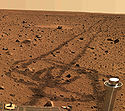
NASA
The National Aeronautics and Space Administration is the agency of the United States government that is responsible for the nation's civilian space program and for aeronautics and aerospace research...
's Mars Exploration Rover Mission (MER) is an ongoing robotic space mission involving two rovers
Mars Rover
A Mars rover is an automated motor vehicle which propels itself across the surface of the planet Mars after landing.Rovers have several advantages over stationary landers: they examine more territory, they can be directed to interesting features, they can place themselves in sunny positions to...
, Spirit and Opportunity, exploring the planet Mars
Mars
Mars is the fourth planet from the Sun in the Solar System. The planet is named after the Roman god of war, Mars. It is often described as the "Red Planet", as the iron oxide prevalent on its surface gives it a reddish appearance...
. It began in 2003 with the sending of the two rover
Rover (space exploration)
A rover is a space exploration vehicle designed to move across the surface of a planet or other astronomical body. Some rovers have been designed to transport members of a human spaceflight crew; others have been partially or fully autonomous robots...
s—MER-A Spirit
Spirit rover
Spirit, MER-A , is a robotic rover on Mars, active from 2004 to 2010. It was one of two rovers of NASA's ongoing Mars Exploration Rover Mission. It landed successfully on Mars at 04:35 Ground UTC on January 4, 2004, three weeks before its twin, Opportunity , landed on the other side of the planet...
and MER-B Opportunity
Opportunity rover
Opportunity, MER-B , is a robotic rover on the planet Mars, active since 2004. It is the remaining rover in NASA's ongoing Mars Exploration Rover Mission...
—to explore the Martian surface and geology
Geology of Mars
The geology of Mars is the scientific study of the surface, crust, and interior of the planet Mars. It emphasizes the composition, structure, history, and physical processes that shape the planet. It is fully analogous to the field of terrestrial geology. In planetary science, the term geology is...
.
The mission's scientific objective was to search for and characterize a wide range of rocks
Rock (geology)
In geology, rock or stone is a naturally occurring solid aggregate of minerals and/or mineraloids.The Earth's outer solid layer, the lithosphere, is made of rock. In general rocks are of three types, namely, igneous, sedimentary, and metamorphic...
and soil
Soil
Soil is a natural body consisting of layers of mineral constituents of variable thicknesses, which differ from the parent materials in their morphological, physical, chemical, and mineralogical characteristics...
s that hold clues to past water activity on Mars. The mission is part of NASA's Mars Exploration Program, which includes three previous successful landers: the two Viking program
Viking program
The Viking program consisted of a pair of American space probes sent to Mars, Viking 1 and Viking 2. Each spacecraft was composed of two main parts, an orbiter designed to photograph the surface of Mars from orbit, and a lander designed to study the planet from the surface...
landers in 1976 and Mars Pathfinder
Mars Pathfinder
Mars Pathfinder was an American spacecraft that landed a base station with roving probe on Mars in 1997. It consisted of a lander, renamed the Carl Sagan Memorial Station, and a lightweight wheeled robotic rover named Sojourner.Launched on December 4, 1996 by NASA aboard a Delta II booster a...
probe in 1997.
The total cost of building, launching, landing and operating the rovers on the surface for the initial 90-Martian-day (sol) primary mission was US$820 million. Since the rovers have continued to function beyond their initial 90 sol primary mission, they have each received five mission extensions. The fifth mission extension was granted in October 2007, and runs to the end of 2009. The total cost of the first four mission extensions was $104 million, and the fifth mission extension is expected to cost at least $20 million.
In July 2007, during the fourth mission extension, Martian dust storms blocked sunlight to the rovers and threatened the ability of the craft to gather energy through their solar panel
Photovoltaic module
A solar panel is a packaged, connected assembly of solar cells, also known as photovoltaic cells...
s, causing engineers to fear that one or both of them might be permanently disabled. However, the dust storms lifted, allowing them to resume operations.
On May 1, 2009, during its fifth mission extension, Spirit became stuck in soft soil on Mars. After nearly nine months of attempts to get the rover back on track, including using test rovers on Earth, NASA announced on January 26, 2010 that Spirit was being retasked as a stationary science platform. This mode would enable Spirit to assist scientists in ways that a mobile platform could not, such as detecting "wobbles
Chandler wobble
The Chandler wobble is a small motion in the Earth's axis of rotation relative to the Earth's surface, which was discovered by American astronomer Seth Carlo Chandler in 1891. It amounts to on the Earth's surface and has a period of 433 days...
" in the planet's rotation that would indicate a liquid core. Jet Propulsion Laboratory (JPL) lost contact with Spirit after last hearing from the rover on March 22, 2010 and continued attempts to regain communications until May 25, 2011 bringing the elapsed mission time to 6 years 2 months 19 days or over 25 times the original planned mission duration.
In recognition of the vast amount of scientific information
Scientific information from the Mars Exploration Rover mission
NASA's 2003 Mars Exploration Rover Mission has amassed an enormous amount of scientific information related to the Martian geology and atmosphere, as well as providing some astronomical observations from Mars. This article covers information gathered by the Opportunity rover during the initial...
amassed by both rovers, two asteroid
Asteroid
Asteroids are a class of small Solar System bodies in orbit around the Sun. They have also been called planetoids, especially the larger ones...
s have been named in their honor: 37452 Spirit
37452 Spirit
Asteroid 37452 Spirit was discovered on September 24, 1960 by Ingrid van Houten-Groeneveld, Cornelis Johannes van Houten, and Tom Gehrels. The asteroid was spotted by examining photographic plates of images taken by telescopes at the Palomar Observatory. 37452 Spirit is part of a small group of...
and 39382 Opportunity
39382 Opportunity
Asteroid 39382 Opportunity was discovered on September 24, 1960, by Ingrid van Houten-Groeneveld, Cornelis Johannes van Houten and Tom Gehrels. The asteroid was spotted by examining photographic plates taken by telescopes at the Palomar Observatory....
. The mission is managed for NASA
NASA
The National Aeronautics and Space Administration is the agency of the United States government that is responsible for the nation's civilian space program and for aeronautics and aerospace research...
by the Jet Propulsion Laboratory
Jet Propulsion Laboratory
Jet Propulsion Laboratory is a federally funded research and development center and NASA field center located in the San Gabriel Valley area of Los Angeles County, California, United States. The facility is headquartered in the city of Pasadena on the border of La Cañada Flintridge and Pasadena...
, which designed, built, and is operating the rovers.
Objectives
The scientific objectives of the Mars Exploration Rover mission are to:- Search for and characterize a variety of rocks and soils that hold clues to past waterWater on MarsWater on Mars is a psychedelic rock and electronic music group from Quebec City, Québec, Canada. The music trio is led by Philippe Navarro, guitarist, vocalist, arranger, producer, principal lyricist, and music composer....
activity. In particular, samples sought include those that have minerals deposited by water-related processes such as precipitationPrecipitation (meteorology)In meteorology, precipitation In meteorology, precipitation In meteorology, precipitation (also known as one of the classes of hydrometeors, which are atmospheric water phenomena is any product of the condensation of atmospheric water vapor that falls under gravity. The main forms of precipitation...
, evaporationWater vaporWater vapor or water vapour , also aqueous vapor, is the gas phase of water. It is one state of water within the hydrosphere. Water vapor can be produced from the evaporation or boiling of liquid water or from the sublimation of ice. Under typical atmospheric conditions, water vapor is continuously...
, sedimentary cementationSedimentary rockSedimentary rock are types of rock that are formed by the deposition of material at the Earth's surface and within bodies of water. Sedimentation is the collective name for processes that cause mineral and/or organic particles to settle and accumulate or minerals to precipitate from a solution....
, or hydrothermal activity. - Determine the distribution and composition of minerals, rocks, and soils surrounding the landing sites.
- Determine what geologic processesGeology of MarsThe geology of Mars is the scientific study of the surface, crust, and interior of the planet Mars. It emphasizes the composition, structure, history, and physical processes that shape the planet. It is fully analogous to the field of terrestrial geology. In planetary science, the term geology is...
have shaped the local terrain and influenced the chemistry. Such processes could include water or wind erosion, sedimentation, hydrothermal mechanisms, volcanism, and cratering. - Perform calibration and validation of surface observations made by Mars Reconnaissance OrbiterMars Reconnaissance OrbiterMars Reconnaissance Orbiter is a NASA multipurpose spacecraft designed to conduct reconnaissance and Exploration of Mars from orbit...
instruments. This will help determine the accuracy and effectiveness of various instruments that survey Martian geology from orbit. - Search for ironIronIron is a chemical element with the symbol Fe and atomic number 26. It is a metal in the first transition series. It is the most common element forming the planet Earth as a whole, forming much of Earth's outer and inner core. It is the fourth most common element in the Earth's crust...
-containing minerals, and to identify and quantify relative amounts of specific mineral types that contain water or were formed in water, such as iron-bearing carbonates. - Characterize the mineralogyMineralogyMineralogy is the study of chemistry, crystal structure, and physical properties of minerals. Specific studies within mineralogy include the processes of mineral origin and formation, classification of minerals, their geographical distribution, as well as their utilization.-History:Early writing...
and textures of rocks and soils to determine the processes that created them. - Search for geological clues to the environmental conditionsEnvironmental scienceEnvironmental science is an interdisciplinary academic field that integrates physical and biological sciences, to the study of the environment, and the solution of environmental problems...
that existed when liquid water was present. - Assess whether those environments were conducive to lifeLifeLife is a characteristic that distinguishes objects that have signaling and self-sustaining processes from those that do not, either because such functions have ceased , or else because they lack such functions and are classified as inanimate...
.
During the next two decades, NASA will conduct several missions to address whether life ever existed on Mars. The search begins with determining whether the Martian environment was ever suitable for life. Life, as humans understand it, requires water, hence the history of water on Mars is critical to finding out if the Martian environment was ever conducive to life. Although the Mars Exploration Rovers do not have the ability to detect life directly, they offer important information on the habitability of the environment in the planet's history
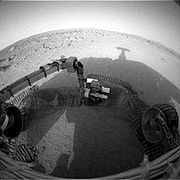
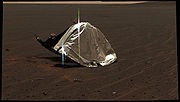
History
The probes were launched June and July 2003 and landed January 2004 in widely separated equatorial places on Mars.On January 21, 2004, the Deep Space Network
Deep Space Network
The Deep Space Network, or DSN, is a world-wide network of large antennas and communication facilities that supports interplanetary spacecraft missions. It also performs radio and radar astronomy observations for the exploration of the solar system and the universe, and supports selected...
lost contact with Spirit, for reasons originally thought to be related to a thunderstorm
Thunderstorm
A thunderstorm, also known as an electrical storm, a lightning storm, thundershower or simply a storm is a form of weather characterized by the presence of lightning and its acoustic effect on the Earth's atmosphere known as thunder. The meteorologically assigned cloud type associated with the...
over Australia
Australia
Australia , officially the Commonwealth of Australia, is a country in the Southern Hemisphere comprising the mainland of the Australian continent, the island of Tasmania, and numerous smaller islands in the Indian and Pacific Oceans. It is the world's sixth-largest country by total area...
. The rover transmitted a message with no data, but later that day missed another communications session with the Mars Global Surveyor
Mars Global Surveyor
The Mars Global Surveyor was a US spacecraft developed by NASA's Jet Propulsion Laboratory and launched November 1996. It began the United States's return to Mars after a 10-year absence. It completed its primary mission in January 2001 and was in its third extended mission phase when, on 2...
. The next day, JPL received a beep from the rover, indicating that it was in fault mode. On January 23, the flight team succeeded in making the rover send. The fault was believed to have been caused by an error in the rover's flash memory
Flash memory
Flash memory is a non-volatile computer storage chip that can be electrically erased and reprogrammed. It was developed from EEPROM and must be erased in fairly large blocks before these can be rewritten with new data...
subsystem. The rover did not perform any scientific activities for ten days, while engineers updated its software and ran tests. The problem was corrected by reformatting Spirits flash memory and using a software patch to avoid memory overload; Opportunity was also upgraded with the patch as a precaution. Spirit returned to full scientific operations by February 5.
On March 23, 2004, a news conference was held announcing "major discoveries" of evidence of past liquid water
Water
Water is a chemical substance with the chemical formula H2O. A water molecule contains one oxygen and two hydrogen atoms connected by covalent bonds. Water is a liquid at ambient conditions, but it often co-exists on Earth with its solid state, ice, and gaseous state . Water also exists in a...
on the Martian surface. A delegation of scientists showed pictures and data revealing a stratified pattern and cross bedding in the rocks of the outcrop inside a crater in Meridiani Planum
Meridiani Planum
Meridiani Planum is a plain located 2 degrees south of Mars' equator , in the westernmost portion of Terra Meridiani. It hosts a rare occurrence of gray crystalline hematite...
, landing site of MER-B, Opportunity. This suggested that water once flowed in the region. The irregular distribution of chlorine
Chlorine
Chlorine is the chemical element with atomic number 17 and symbol Cl. It is the second lightest halogen, found in the periodic table in group 17. The element forms diatomic molecules under standard conditions, called dichlorine...
and bromine
Bromine
Bromine ") is a chemical element with the symbol Br, an atomic number of 35, and an atomic mass of 79.904. It is in the halogen element group. The element was isolated independently by two chemists, Carl Jacob Löwig and Antoine Jerome Balard, in 1825–1826...
also suggests that the place was once the shoreline of a salty sea, now evaporated.
On April 8, 2004, NASA announced that it was extending the mission life of the rovers from three to eight months. It immediately provided additional funding of US $15 million through September, and $2.8 million per month for continuing operations. Later that month, Opportunity arrived at Endurance crater
Endurance (crater)
Endurance is an impact crater on Mars that was visited by the Opportunity rover from May until December 2004. Mission scientists named the crater after the ship Endurance that sailed to the Antarctic in an exploration voyage organized by Ernest Shackleton.The rover entered the crater interior on...
, taking about five days to drive the 200 meters. NASA announced on September 22 that it was extending the mission life of the rovers for another six months. Opportunity was to leave Endurance crater, visit its discarded heat shield, and proceed to Victoria crater
Victoria (crater)
Victoria is an impact crater on Mars located at 2.05°S, 5.50°W in Meridiani Planum, visited by the Mars Exploration Rover Opportunity. It is roughly 730 metres wide, nearly eight times the size of the crater Endurance, visited by Opportunity from sols 951 to 1630...
. Spirit was to attempt to climb to the top of the Columbia Hills.
With the two rovers still functioning well, NASA later announced another 18 month extension of the mission to September 2006. Opportunity was to visit the "Etched Terrain" and Spirit was to climb a rocky slope toward the top of Husband Hill
Husband Hill
Husband Hill is one of the Columbia Hills in Gusev crater, Mars, which are close to the landing site of NASA's Spirit rover. It was named in honor of Rick D...
. On August 21, 2005, Spirit reached the summit of Husband Hill after 581 sols and a journey of 4.81 kilometres (3 mi).

Home Plate (Mars)
Home Plate is a plateau roughly 90 m across within the Columbia Hills, Mars. It is informally named for its similarity in shape to a baseball home plate. Home Plate is a rocky outcrop that appears to show layered features....
. It is a layered rock outcrop that puzzles and excites scientists. It is thought that its rocks are explosive volcanic deposits, though other possibilities exist, including impact deposits or sediment borne by wind or water.
Spirits front right wheel ceased working on March 13, 2006, while the rover was moving itself to McCool Hill
McCool Hill
McCool Hill is the tallest of the Columbia Hills in Gusev crater, Mars. It was named in honor of William C. McCool, an astronaut of the Space Shuttle Columbia during its final mission where it disintegrated during atmospheric reentry .The hill was to be Spirit rover's next target...
. Its drivers attempted to drag the dead wheel behind Spirit, but this only worked until reaching an impassable sandy area on the lower slopes. Drivers directed Spirit to a smaller sloped feature, dubbed "Low Ridge Haven", where it spent the long Martian winter, waiting for spring and increased solar power levels suitable for driving. That September, Opportunity reached the rim of Victoria crater, and Spaceflight Now reported that NASA had extended mission for the two rovers through September 2007. On February 6, 2007, Opportunity became the first spacecraft to traverse ten kilometers (10,000 meters) on the surface of Mars.
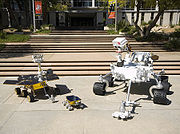
On October 1, 2007, both Spirit and Opportunity entered their fifth mission extension that extended operations into 2009, allowing the rovers to have spent five years exploring the Martian surface, pending their continued survival.
On August 26, 2008, Opportunity began its three-day climb out of Victoria crater amidst concerns that power spikes, similar to those seen on Spirit before the failure of its right-front wheel, might prevent it from ever being able to leave the crater if a wheel failed. Project scientist Bruce Banerdt also said, "We've done everything we entered Victoria Crater to do and more." Opportunity will return to the plains in order to characterize Meridiani Planum's vast diversity of rocks—some of which may have been blasted out of craters such as Victoria. The rover had been exploring Victoria Crater since September 11, 2007. As of January 2009, the two rovers had collectively sent back 250,000 images and traveled over 21 kilometres (13 mi).
After driving about 3.2 kilometres (2 mi) since it left Victoria crater, Opportunity first saw the rim of Endeavour crater
Endeavour (crater)
Endeavour is an impact crater located in Meridiani Planum on Mars. Endeavour is in diameter. Using Mars Reconnaissance Orbiter data, phyllosilicate-bearing outcrops have been detected along the rim of this crater. These minerals may have formed under wet conditions in a low-acidic environment...
on March 7, 2009. It passed the 10-mile mark (16 kilometers) along the way on sol 1897. Meanwhile, at Gusev crater, Spirit was dug in deep into the Martian sand, much as Opportunity was at Purgatory Dune in 2005.
On January 3 and January 24, 2010, Spirit and Opportunity marked six years on Mars, respectively. On January 26, NASA announced that Spirit will be used as a stationary research platform after several months of unsuccessful attempts to free the rover from soft sand.
NASA announced on March 24, 2010, that Opportunity, which has an estimated remaining drive distance of 12 km to Endeavour Crater, has traveled over 20 km since the start of its mission. Each rover was designed with a mission driving distance goal of just 600 meters. One week later, they announced that Spirit may have gone into hibernation for the Martian winter and might not wake up again for months.
On September 8, 2010, it was announced that Opportunity had reached the halfway point of the 19-kilometer journey between Victoria crater and Endeavour crater.
On May 24, 2011, NASA announced that it will cease attempts to contact Spirit, which has been stuck in a sand trap for two years. The last successful communication with the rover was on March 22, 2010. The final transmission to the rover was on May 25, 2011.
Spacecraft design


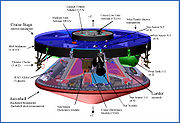
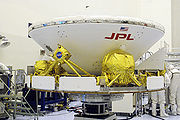

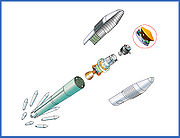
- Rover: 185 kg (408 lb)
- Lander: 348 kg (767 lb)
- Backshell / Parachute: 209 kg (461 lb)
- Heat Shield: 78 kg (172 lb)
- Cruise Stage: 193 kg (425 lb)
- Propellant: 50 kg (110 lb)
- Instruments: 5 kg (11 lb)
Total mass is 1,063 kg (2,343 lb).
Cruise stage
The cruise stage is the component of the spacecraft that is used for travel from Earth to Mars. It is very similar to the Mars Pathfinder in design and is approximately 2.65 metersMetre
The metre , symbol m, is the base unit of length in the International System of Units . Originally intended to be one ten-millionth of the distance from the Earth's equator to the North Pole , its definition has been periodically refined to reflect growing knowledge of metrology...
(8.7 ft) in diameter
Diameter
In geometry, a diameter of a circle is any straight line segment that passes through the center of the circle and whose endpoints are on the circle. The diameters are the longest chords of the circle...
and 1.6 m (5.2 ft) tall, including the entry vehicle (see below).
The primary structure is aluminium
Aluminium
Aluminium or aluminum is a silvery white member of the boron group of chemical elements. It has the symbol Al, and its atomic number is 13. It is not soluble in water under normal circumstances....
with an outer ring of ribs covered by the solar panel
Photovoltaic module
A solar panel is a packaged, connected assembly of solar cells, also known as photovoltaic cells...
s, which are about 2.65 m (8.7 ft) in diameter. Divided into five sections, the solar arrays can provide up to 600 watt
Watt
The watt is a derived unit of power in the International System of Units , named after the Scottish engineer James Watt . The unit, defined as one joule per second, measures the rate of energy conversion.-Definition:...
s of power near Earth and 300 W at Mars.
Heaters and multi-layer insulation
Multi-layer insulation
Multi-layer insulation, or MLI, is thermal insulation composed of multiple layers of thin sheets often used on spacecraft. It one of the main items of the spacecraft thermal design, mainly intended to reduce heat loss by thermal radiation. In its basic form, it does not appreciably insulate...
keep the electronics "warm". A freon system removes heat from the flight computer and communications hardware inside the rover so they do not overheat. Cruise avionics systems allow the flight computer to interface with other electronics, such as the sun sensors, star scanner and heaters.
Navigation
The star scanner (with a backup system) and sun sensor allowed the spacecraft to know its orientation in space by analyzing the position of the Sun and other stars in relation to itself. Sometimes the craft could be slightly off course; this was expected, given the 500 million kilometer (320 million mile) journey. Thus navigators planned up to six trajectory correction maneuvers, along with health checks.To ensure the spacecraft arrived at Mars in the right place for its landing, two light-weight, aluminium-lined tanks carried about 31 kg (about 68 lb) of hydrazine
Hydrazine
Hydrazine is an inorganic compound with the formula N2H4. It is a colourless flammable liquid with an ammonia-like odor. Hydrazine is highly toxic and dangerously unstable unless handled in solution. Approximately 260,000 tons are manufactured annually...
propellant
Propellant
A propellant is a material that produces pressurized gas that:* can be directed through a nozzle, thereby producing thrust ;...
. Along with cruise guidance and control systems, the propellant allowed navigators to keep the spacecraft on course. Burns and pulse firings of the propellant allowed three types of maneuvers:
- An axial burn uses pairs of thrusters to change spacecraft velocity;
- A lateral burn uses two "thruster clusters" (four thrusters per cluster) to move the spacecraft "sideways" through seconds-long pulses;
- Pulse mode firing uses coupled thruster pairs for spacecraft precessionPrecessionPrecession is a change in the orientation of the rotation axis of a rotating body. It can be defined as a change in direction of the rotation axis in which the second Euler angle is constant...
maneuvers (turns).
Communication
The spacecraft used a high-frequency X bandX band
The X band is a segment of the microwave radio region of the electromagnetic spectrum. In some cases, such as in communication engineering, the frequency range of X band is rather indefinitely set at approximately 7.0 to 11.2 gigahertz . In radar engineering, the frequency range is specified...
radio
Radio
Radio is the transmission of signals through free space by modulation of electromagnetic waves with frequencies below those of visible light. Electromagnetic radiation travels by means of oscillating electromagnetic fields that pass through the air and the vacuum of space...
wavelength
Wavelength
In physics, the wavelength of a sinusoidal wave is the spatial period of the wave—the distance over which the wave's shape repeats.It is usually determined by considering the distance between consecutive corresponding points of the same phase, such as crests, troughs, or zero crossings, and is a...
to communicate, which allowed for less power and smaller antennas than many older craft, which used S band
S band
The S band is defined by an IEEE standard for radio waves with frequencies that range from 2 to 4 GHz, crossing the conventional boundary between UHF and SHF at 3.0 GHz. It is part of the microwave band of the electromagnetic spectrum...
.
Navigators sent commands through two antennas on the cruise stage: a cruise low-gain antenna
Low-gain antenna
A low-gain antenna is an antenna with a broad radiowave beam width. This very wide beam allows for a more reliable signal that is best used in mountainous regions, where the signal will propagate reasonably well regardless of terrain. The mountains become the equivalent of rocks in a stream,...
mounted inside the inner ring, and a cruise medium-gain antenna in the outer ring. The low-gain antenna was used close to Earth. It is omni-directional, so the transmission power that reached Earth fell faster with increasing distance. As the craft moved closer to Mars, the Sun and Earth moved closer in the sky as viewed from the craft, so less energy reached Earth. The spacecraft then switched to the medium-gain antenna, which directed the same amount of transmission power into a tighter beam toward Earth.
During flight, the spacecraft was spin-stabilized
Gyroscope
A gyroscope is a device for measuring or maintaining orientation, based on the principles of angular momentum. In essence, a mechanical gyroscope is a spinning wheel or disk whose axle is free to take any orientation...
with a spin rate of two revolutions per minute
Revolutions per minute
Revolutions per minute is a measure of the frequency of a rotation. It annotates the number of full rotations completed in one minute around a fixed axis...
(rpm). Periodic updates kept antennas pointed toward Earth and solar panels toward the Sun.
Aeroshell
The aeroshell maintained a protective covering for the lander during the seven month voyage to Mars. Together with the lander and the rover, it constituted the "entry vehicle". Its main purpose was to protect the lander and the rover inside it from the intense heat of entry into the thin Martian atmosphere. It was based on the Mars Pathfinder and Mars Viking designs.Parts
The aeroshell was made of two main parts: a heat shieldHeat shield
A heat shield is designed to shield a substance from absorbing excessive heat from an outside source by either dissipating, reflecting or simply absorbing the heat...
and a backshell. The heat shield was flat and brownish, and protected the lander and rover during entry into the Martian atmosphere and acted as the first aerobrake for the spacecraft. The backshell was large, cone-shaped and painted white. It carried the parachute
Parachute
A parachute is a device used to slow the motion of an object through an atmosphere by creating drag, or in the case of ram-air parachutes, aerodynamic lift. Parachutes are usually made out of light, strong cloth, originally silk, now most commonly nylon...
and several components used in later stages of entry, descent, and landing, including:
- A parachute (stowed at the top of the backshell);
- The backshell electronics and batteries that fire off pyrotechnic devices like separation nuts, rockets and the parachute mortar;
- A Litton LN-200 Inertial Measurement Unit (IMU), which monitors and reports the orientation of the backshell as it swings under the parachute;
- Three large solid rocketSolid rocketA solid rocket or a solid-fuel rocket is a rocket engine that uses solid propellants . The earliest rockets were solid-fuel rockets powered by gunpowder; they were used by the Chinese in warfare as early as the 13th century and later by the Mongols, Arabs, and Indians.All rockets used some form of...
motors called RAD rockets (Rocket Assisted Descent), each providing about a ton of force (10 kilonewtons) for about 4 seconds; - Three small solid rockets called TIRS (mounted so that they aim horizontally out the sides of the backshell) that provide a small horizontal kick to the backshell to help orient the backshell more vertically during the main RAD rocket burn.
Composition
Built by the Lockheed MartinLockheed Martin
Lockheed Martin is an American global aerospace, defense, security, and advanced technology company with worldwide interests. It was formed by the merger of Lockheed Corporation with Martin Marietta in March 1995. It is headquartered in Bethesda, Maryland, in the Washington Metropolitan Area....
Astronautics Co. in Denver, Colorado, the aeroshell is made of an aluminium honeycomb structure sandwiched between graphite-epoxy face sheets. The outside of the aeroshell is covered with a layer of phenol
Phenol
Phenol, also known as carbolic acid, phenic acid, is an organic compound with the chemical formula C6H5OH. It is a white crystalline solid. The molecule consists of a phenyl , bonded to a hydroxyl group. It is produced on a large scale as a precursor to many materials and useful compounds...
ic honeycomb. This honeycomb is filled with an ablative
Ablation
Ablation is removal of material from the surface of an object by vaporization, chipping, or other erosive processes. This occurs in spaceflight during ascent and atmospheric reentry, glaciology, medicine, and passive fire protection.-Spaceflight:...
material (also called an "ablator"), that dissipates heat generated by atmospheric friction.
The ablator itself is a unique blend of cork
Cork (material)
Cork is an impermeable, buoyant material, a prime-subset of bark tissue that is harvested for commercial use primarily from Quercus suber , which is endemic to southwest Europe and northwest Africa...
wood
Wood
Wood is a hard, fibrous tissue found in many trees. It has been used for hundreds of thousands of years for both fuel and as a construction material. It is an organic material, a natural composite of cellulose fibers embedded in a matrix of lignin which resists compression...
, binder
Binder
The reaper-binder, or binder, was a farm implement that improved upon the reaper. The binder was invented in 1872 by Charles Withington. In addition to cutting the small-grain crop, it would also tie the stems into small bundles, or sheaves...
and many tiny silica glass spheres. It was invented for the heat shields flown on the Viking Mars lander missions. A similar technology was used in the first US manned space missions Mercury
Mercury program
Mercury Program might refer to:*the first successful American manned spaceflight program, Project Mercury*an American post-rock band, The Mercury Program...
, Gemini and Apollo. It was specially formulated to react chemically with the Martian atmosphere during entry and carry heat away, leaving a hot wake of gas behind the vehicle. The vehicle slowed from 19000 km/h (about 12000 mph) to about 1600 km/h (1000 mph) in about a minute, producing about 60 m/s² (6 g
G-force
The g-force associated with an object is its acceleration relative to free-fall. This acceleration experienced by an object is due to the vector sum of non-gravitational forces acting on an object free to move. The accelerations that are not produced by gravity are termed proper accelerations, and...
) of acceleration
Acceleration
In physics, acceleration is the rate of change of velocity with time. In one dimension, acceleration is the rate at which something speeds up or slows down. However, since velocity is a vector, acceleration describes the rate of change of both the magnitude and the direction of velocity. ...
on the lander and rover.
The backshell and heat shield are made of the same materials, but the heat shield has a thicker, 1/2 in, layer of the ablator. Instead of being painted, the backshell was covered with a very thin aluminized PET film
PET film (biaxially oriented)
BoPET is a polyester film made from stretched polyethylene terephthalate and is used for its high tensile strength, chemical and dimensional stability, transparency, reflectivity, gas and aroma barrier properties and electrical insulation.A variety of companies manufacture boPET and other...
blanket to protect it from the cold of deep space. The blanket vaporized during entry into the Martian atmosphere.
Parachute
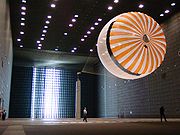
Design
The 2003 parachute design was part of a long-term Mars parachute technology development effort and is based on the designs and experience of the Viking and Pathfinder missions. The parachute for this mission is 40% larger than Pathfinder's because the largest load for the Mars Exploration Rover is 80 to 85 kilonewtons (kN) or 18,000 to 19000 lbf (84.5 kN) when the parachute fully inflates. By comparison, Pathfinder's inflation loads were approximately 35 kN (about 8,000 lbf). The parachute was designed and constructed in South Windsor, ConnecticutSouth Windsor, Connecticut
-History:In 1659, Thomas Burnham purchased the tract of land now covered by the towns of South Windsor and East Hartford from Tantinomo, chief sachem of the Podunk Indians. Burnham lived on the land and later willed it to his nine children...
by Pioneer Aerospace, the company that also designed the parachute for the Stardust
Stardust (spacecraft)
Stardust is a 300-kilogram robotic space probe launched by NASA on February 7, 1999 to study the asteroid 5535 Annefrank and collect samples from the coma of comet Wild 2. The primary mission was completed January 15, 2006, when the sample return capsule returned to Earth...
mission.
Composition
The parachute is made of two durable, lightweight fabrics: polyesterPolyester
Polyester is a category of polymers which contain the ester functional group in their main chain. Although there are many polyesters, the term "polyester" as a specific material most commonly refers to polyethylene terephthalate...
and nylon
Nylon
Nylon is a generic designation for a family of synthetic polymers known generically as polyamides, first produced on February 28, 1935, by Wallace Carothers at DuPont's research facility at the DuPont Experimental Station...
. A triple bridle made of Kevlar
Kevlar
Kevlar is the registered trademark for a para-aramid synthetic fiber, related to other aramids such as Nomex and Technora. Developed at DuPont in 1965, this high strength material was first commercially used in the early 1970s as a replacement for steel in racing tires...
connects the parachute to the backshell.
The amount of space available on the spacecraft for the parachute is so small that the parachute had to be pressure-packed. Before launch, a team tightly folded the 48 suspension lines, three bridle lines, and the parachute. The parachute team loaded the parachute in a special structure that then applied a heavy weight to the parachute package several times. Before placing the parachute into the backshell, the parachute was heat set to sterilize
Sterilization (microbiology)
Sterilization is a term referring to any process that eliminates or kills all forms of microbial life, including transmissible agents present on a surface, contained in a fluid, in medication, or in a compound such as biological culture media...
it.
Connected systems
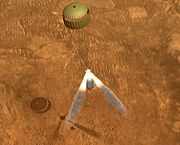
Zylon
Zylon is a trademarked name for a range of thermoset liquid crystalline polyoxazole...
.
Zylon is an advanced fiber material, similar to Kevlar, that is sewn in a webbing pattern (like shoelace material) to make it stronger. The Zylon bridle provides space for airbag deployment, distance from the solid rocket motor exhaust stream, and increased stability. The bridle incorporates an electrical harness that allows the firing of the solid rockets from the backshell as well as provides data from the backshell inertial measurement unit (which measures rate and tilt of the spacecraft) to the flight computer in the rover.
Rocket assisted descent (RAD) motors: Because the atmospheric density of Mars is less than 1% of Earth's, the parachute alone could not slow down the Mars Exploration Rover enough to ensure a safe, low landing speed. The spacecraft descent was assisted by rockets that brought the spacecraft to a dead stop 10–15 m (30–50 ft) above the Martian surface.
Radar altimeter unit: A radar
Radar
Radar is an object-detection system which uses radio waves to determine the range, altitude, direction, or speed of objects. It can be used to detect aircraft, ships, spacecraft, guided missiles, motor vehicles, weather formations, and terrain. The radar dish or antenna transmits pulses of radio...
altimeter
Altimeter
An altimeter is an instrument used to measure the altitude of an object above a fixed level. The measurement of altitude is called altimetry, which is related to the term bathymetry, the measurement of depth underwater.-Pressure altimeter:...
unit was used to determine the distance to the Martian surface. The radar's antenna is mounted at one of the lower corners of the lander tetrahedron. When the radar measurement showed the lander was the correct distance above the surface, the Zylon bridle was cut, releasing the lander from the parachute and backshell so that it was free and clear for landing. The radar data also enabled the timing sequence on airbag inflation and backshell RAD rocket firing.
Airbags
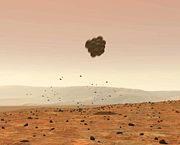
Airbag
An Airbag is a vehicle safety device. It is an occupant restraint consisting of a flexible envelope designed to inflate rapidly during an automobile collision, to prevent occupants from striking interior objects such as the steering wheel or a window...
s used in the Mars Exploration Rover mission are the same type that Mars Pathfinder used in 1997. They had to be strong enough to cushion the spacecraft if it landed on rocks or rough terrain and allow it to bounce across Mars' surface at freeway speeds after landing. The airbags had to be inflated seconds before touchdown and deflated once safely on the ground.
The airbags were made of Vectran
Vectran
Vectran is a manufactured fibre, spun from a liquid crystal polymer created by Celanese Acetate LLC and now manufactured by Kuraray Co., Ltd. Chemically it is an aromatic polyester produced by the polycondensation of 4-hydroxybenzoic acid and 6-hydroxynaphthalene-2-carboxylic acid.- Properties...
, like those on Pathfinder. Vectran has almost twice the strength of other synthetic materials, such as Kevlar, and performs better in cold temperatures. Six 100 denier (10 mg/m) layers of Vectran protected one or two inner bladders of Vectran in 200 denier (20 mg/m). Using 100 denier (10 mg/m) leaves more fabric in the outer layers where it is needed, because there are more threads in the weave.
Each rover used four airbags with six lobes each, all of which were connected. Connection was important, since it helped abate some of the landing forces by keeping the bag system flexible and responsive to ground pressure. The airbags were not attached directly to the rover, but were held to it by ropes crisscrossing the bag structure. The ropes gave the bags shape, making inflation easier. While in flight, the bags were stowed along with three gas generators that are used for inflation.
Lander
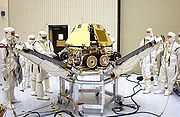
The lander is a tetrahedron
Tetrahedron
In geometry, a tetrahedron is a polyhedron composed of four triangular faces, three of which meet at each vertex. A regular tetrahedron is one in which the four triangles are regular, or "equilateral", and is one of the Platonic solids...
shape, whose sides open like petals. It is strong and light, and made of beams and sheets. The beams consist of layers of graphite
Graphite
The mineral graphite is one of the allotropes of carbon. It was named by Abraham Gottlob Werner in 1789 from the Ancient Greek γράφω , "to draw/write", for its use in pencils, where it is commonly called lead . Unlike diamond , graphite is an electrical conductor, a semimetal...
fiber woven into a fabric that is lighter than aluminium and more rigid than steel
Steel
Steel is an alloy that consists mostly of iron and has a carbon content between 0.2% and 2.1% by weight, depending on the grade. Carbon is the most common alloying material for iron, but various other alloying elements are used, such as manganese, chromium, vanadium, and tungsten...
. Titanium fittings are glued and fitted onto the beams to allow it to be bolted together. The rover was held inside the lander by bolts
Screw
A screw, or bolt, is a type of fastener characterized by a helical ridge, known as an external thread or just thread, wrapped around a cylinder. Some screw threads are designed to mate with a complementary thread, known as an internal thread, often in the form of a nut or an object that has the...
and special nuts that were released after landing with small explosives.
Uprighting
After the lander stopped bouncing and rolling on the ground, it came to rest on the base of the tetrahedron or one of its sides. The sides then opened to make the base horizontal and the rover upright. The sides are connected to the base by hinges, each of which has a motor strong enough to lift the lander. The rover plus lander has a massMass
Mass can be defined as a quantitive measure of the resistance an object has to change in its velocity.In physics, mass commonly refers to any of the following three properties of matter, which have been shown experimentally to be equivalent:...
of about 533 kilograms (1,175 pound
Pound (mass)
The pound or pound-mass is a unit of mass used in the Imperial, United States customary and other systems of measurement...
s). The rover alone weighs about 185 kg (408 lb). The gravity on Mars is about 38% of Earth's, so the motor does not need to be as powerful as it would on Earth.
The rover contains accelerometer
Accelerometer
An accelerometer is a device that measures proper acceleration, also called the four-acceleration. This is not necessarily the same as the coordinate acceleration , but is rather the type of acceleration associated with the phenomenon of weight experienced by a test mass that resides in the frame...
s to detect which way is down (toward the surface of Mars) by measuring the pull of gravity. The rover computer then commanded the correct lander petal to open to place the rover upright. Once the base petal was down and the rover was upright, the other two petals were opened.
The petals initially opened to an equally flat position, so all sides of the lander were straight and level. The petal motors are strong enough so that if two of the petals come to rest on rocks, the base with the rover would be held in place like a bridge above the ground. The base will hold at a level even with the height of the petals resting on rocks, making a straight flat surface throughout the length of the open, flattened lander. The flight team on Earth could then send commands to the rover to adjust the petals and create a safe path for the rover to drive off the lander and onto the Martian surface without dropping off a steep rock.
Moving the payload onto Mars
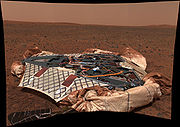
About three hours were allotted to retract the airbags and deploy the lander petals.
Rover design
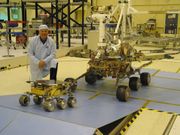
Drive system
Each rover has six wheels mounted on a rocker-bogieRocker-bogie
The Rocker-Bogie system is the suspension arrangement used in the Mars rovers introduced for the Mars Pathfinder and also used on the Mars Exploration Rover and Mars Science Laboratory missions. It is currently NASA's favored design....
suspension system that ensures wheels remain on the ground while driving over rough terrain. The design reduces the range of motion of the rover body by half, and allows the rover to go over obstacles or through holes that are more than a wheel diameter (250 millimetres (9.8 in)) in size. Each wheel also has cleats, providing grip for climbing in soft sand and scrambling over rocks.
Each wheel has its own motor. The two front and two rear wheels each have individual steering motors. This allows the vehicle to turn in place, a full revolution, and to swerve and curve, making arching turns. The rover is designed to withstand a tilt of 45 degrees in any direction without overturning. However, the rover is programmed through its "fault protection limits" in its hazard avoidance software to avoid exceeding tilts of 30 degrees.
Each rover can spin one of its front wheels in place to grind deep into the terrain. It is to remain motionless while the digging wheel is spinning. The rovers have a top speed on flat hard ground of 50 mm/s (2 in/s). The average speed is 10 mm/s, because its hazard avoidance software causes it to stop every 10 seconds for 20 seconds to observe and understand the terrain into which it has driven.
Power and electronic systems
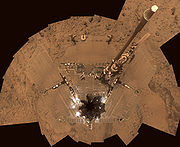
Multijunction photovoltaic cell
Multi-junction solar cells or tandem cells are solar cells containing several p-n junctions. Each junction is tuned to a different wavelength of light, reducing one of the largest inherent sources of losses, and thereby increasing efficiency...
solar arrays generate about 140 watts for up to four hours per Martian day (sol). The rover needs about 100 watts to drive. Its power system includes two rechargeable lithium ion batteries weighing 7.15 kg (16 pounds) each, that provide energy when the sun is not shining, especially at night. Over time, the batteries will degrade and will not be able to recharge to full capacity.
For comparison, the future Mars Science Laboratory
Mars Science Laboratory
The Mars Science Laboratory is a National Aeronautics and Space Administration mission with the aim to land and operate a rover named Curiosity on the surface of Mars. The MSL was launched November 26, 2011, at 10:02 EST and is scheduled to land on Mars at Gale Crater between August 6 and 20, 2012...
's power system is composed of a Multi-Mission Radioisotope Thermoelectric Generator
Multi-Mission Radioisotope Thermoelectric Generator
Multi-Mission Radioisotope Thermoelectric Generator are a type of Radioisotope Thermoelectric Generator developed for NASA space missions including manned ones such as the Apollo program as well as unmanned ones ranging from Viking 1 through the Mars Science Laboratory...
(MMRTG) produced by Boeing. The MMRTG is designed to provide 125W of electrical power at the start of the mission, falling to 100W after 14 years of service. It will be used to power the MSL's many systems and instruments. Solar panels were also considered for the MSL, but RTGs provide constant power, regardless of the time of day, and thus the versatility to work in dark environments and high latitudes where solar energy is not readily available. The MSL will generate 2.5 kilowatt hours per day, compared to the Mars Exploration Rovers, which can generate about 0.6 kilowatt hours per day.
It was thought that by the end of the 90-sol mission, the capability of the solar arrays to generate power would likely be reduced to about 50 watts. This was due to anticipated dust coverage on the solar arrays, and the change in season. Over three Earth years later, however, the rovers' power supplies hovered between 300 watt-hour
Watt-hour
The kilowatt hour, or kilowatt-hour, is a unit of energy equal to 1000 watt hours or 3.6 megajoules.For constant power, energy in watt hours is the product of power in watts and time in hours...
s and 900 watt-hours per day, depending on dust coverage. Cleaning events (dust removal by wind) have occurred more often than NASA expected, keeping the arrays relatively free of dust and extending the life of the mission. During a 2007 global dust storm on Mars, both rovers experienced some of the lowest power of the mission; Opportunity dipped to 128 watt-hours. In November 2008, Spirit had overtaken this low-energy record with a production of 89 watt-hours, due to dust storms in the region of Gusev crater.
The rovers run a VxWorks
VxWorks
VxWorks is a real-time operating system developed as proprietary software by Wind River Systems of Alameda, California, USA. First released in 1987, VxWorks is designed for use in embedded systems.- History :...
embedded operating system
Embedded operating system
An embedded operating system is an operating system for embedded computer systems. These operating systems are designed to be compact, efficient, and reliable, forsaking many functions that non-embedded computer operating systems provide, and which may not be used by the specialized applications...
on a radiation-hardened 20 MHz RAD6000
RAD6000
The RAD6000 radiation-hardened single board computer, based on the IBM RISC Single Chip CPU, was manufactured by IBM Federal Systems. IBM Federal Systems was sold to Loral, and by way of acquisition, ended up with Lockheed Martin and is currently a part of BAE Systems...
CPU
Central processing unit
The central processing unit is the portion of a computer system that carries out the instructions of a computer program, to perform the basic arithmetical, logical, and input/output operations of the system. The CPU plays a role somewhat analogous to the brain in the computer. The term has been in...
with 128 MB
Megabyte
The megabyte is a multiple of the unit byte for digital information storage or transmission with two different values depending on context: bytes generally for computer memory; and one million bytes generally for computer storage. The IEEE Standards Board has decided that "Mega will mean 1 000...
of DRAM
Dram
Dram or DRAM may refer to:As a unit of measure:* Dram , an imperial unit of mass and volume* Armenian dram, a monetary unit* Dirham, a unit of currency in several Arab nationsOther uses:...
with error detection and correction and 3 MB of EEPROM
EEPROM
EEPROM stands for Electrically Erasable Programmable Read-Only Memory and is a type of non-volatile memory used in computers and other electronic devices to store small amounts of data that must be saved when power is removed, e.g., calibration...
. Each rover also has 256 MB of flash memory
Flash memory
Flash memory is a non-volatile computer storage chip that can be electrically erased and reprogrammed. It was developed from EEPROM and must be erased in fairly large blocks before these can be rewritten with new data...
. To survive during the various mission phases, the rover's vital instruments must stay within a temperature of −40 °C to +40 °C (−40 °F to 104 °F). At night, the rovers are heated by eight radioisotope heater units (RHU), which each continuously generate 1 W
Watt
The watt is a derived unit of power in the International System of Units , named after the Scottish engineer James Watt . The unit, defined as one joule per second, measures the rate of energy conversion.-Definition:...
of thermal energy from the decay of radioisotopes, along with electrical heaters that operate only when necessary. A sputtered gold
Gold
Gold is a chemical element with the symbol Au and an atomic number of 79. Gold is a dense, soft, shiny, malleable and ductile metal. Pure gold has a bright yellow color and luster traditionally considered attractive, which it maintains without oxidizing in air or water. Chemically, gold is a...
film and a layer of silica aerogel
Aerogel
Aerogel is a synthetic porous material derived from a gel, in which the liquid component of the gel has been replaced with a gas. The result is a solid with extremely low density and thermal conductivity...
are used for insulation.
Communication
The rover has a low-gainLow-gain antenna
A low-gain antenna is an antenna with a broad radiowave beam width. This very wide beam allows for a more reliable signal that is best used in mountainous regions, where the signal will propagate reasonably well regardless of terrain. The mountains become the equivalent of rocks in a stream,...
and a high-gain antenna
High-gain antenna
A high-gain antenna is an antenna with a focused, narrow radiowave beam width. This narrow beam width allows more precise targeting of the radio signal - also known as a directional antenna...
. The low-gain antenna is omnidirectional
Omnidirectional antenna
In radio communication, an omnidirectional antenna is an antenna which radiates radio wave power uniformly in all directions in one plane, with the radiated power decreasing with elevation angle above or below the plane, dropping to zero on the antenna's axis. This radiation pattern is often...
, and transmits data at a low rate to Deep Space Network
Deep Space Network
The Deep Space Network, or DSN, is a world-wide network of large antennas and communication facilities that supports interplanetary spacecraft missions. It also performs radio and radar astronomy observations for the exploration of the solar system and the universe, and supports selected...
(DSN) antennas on Earth. The high-gain antenna is directional and steerable, and can transmit data to Earth at a higher rate. The rovers also use the low-gain antennas and its Electra
Electra (radio)
Electra, more formally the Electra Proximity Payload, is a software-defined radio defined and implemented by the Jet Propulsion Laboratory for use between spacecraft. It is typically used by a lander to communicate with an orbiter that can then communicate with Earth...
software-defined radio
Software-defined radio
A software-defined radio system, or SDR, is a radio communication system where components that have been typically implemented in hardware are instead implemented by means of software on a personal computer or embedded computing devices...
to communicate with spacecraft orbiting Mars, the Mars Odyssey and (before its failure) the Mars Global Surveyor
Mars Global Surveyor
The Mars Global Surveyor was a US spacecraft developed by NASA's Jet Propulsion Laboratory and launched November 1996. It began the United States's return to Mars after a 10-year absence. It completed its primary mission in January 2001 and was in its third extended mission phase when, on 2...
(using its Mars Relay antenna and Mars Orbiter Camera
Mars Orbiter Camera
The Mars Orbiter Camera or Mars Observer Camera was a scientific instrument on board the Mars Observer and Mars Global Surveyor spacecrafts...
's memory buffer to transfer more than 7.6 terabit
Terabit
The terabit is a multiple of the unit bit for digital information or computer storage. The prefix tera is defined in the International System of Units as a multiplier of 1012 , and therefore...
s of data). The orbiters relay data from and to Earth; most data to Earth is relayed through Odyssey. The orbiters are closer to the rovers than the antennas on Earth, and have a view of Earth for much longer than the rovers. The orbiters communicate with the rovers using UHF antennas, which have shorter range than the low and high-gain antennas. One UHF antenna is on the rover, and one is on a petal of the lander to aid in gaining information during the critical landing event.
Each rover has a total of 9 cameras, which produce 1024-pixel by 1024-pixel images at 12 bits per pixel, but most navigation camera images and image thumbnails are truncated to 8 bits per pixel to conserve memory and transmission time. All images are then compressed using ICER
ICER
ICER is a wavelet-based image compression file format used by the NASA Mars Rovers. ICER has both lossy and lossless compression modes.The Mars Exploration Rovers “Spirit” and “Opportunity” both use ICER...
before being stored and sent to Earth. Navigation, thumbnail, and many other image types are compressed to approximately 0.8 to 1.1 bits/pixel. Lower bit rates (less than 0.5 bit/pixel) are used for certain wavelengths of multi-color panoramic images.
ICER is based on wavelets, and was designed specifically for deep-space applications. It produces progressive compression, both lossless and lossy, and incorporates an error-containment scheme to limit the effects of data loss on the deep-space channel. It outperforms the lossy JPEG image compressor and the lossless Rice compressor used by the Mars Pathfinder
Mars Pathfinder
Mars Pathfinder was an American spacecraft that landed a base station with roving probe on Mars in 1997. It consisted of a lander, renamed the Carl Sagan Memorial Station, and a lightweight wheeled robotic rover named Sojourner.Launched on December 4, 1996 by NASA aboard a Delta II booster a...
mission.
Scientific instrumentation

- Panoramic Camera (Pancam), for determining the texture, color, mineralogyMineralogyMineralogy is the study of chemistry, crystal structure, and physical properties of minerals. Specific studies within mineralogy include the processes of mineral origin and formation, classification of minerals, their geographical distribution, as well as their utilization.-History:Early writing...
, and structure of the local terrain. - Navigation Camera (Navcam), that has higher field of view but lower resolution and is monochromatic, for navigation and driving.
- A mirror for the Miniature Thermal Emission Spectrometer (Mini-TESMini-TES]The Miniature Thermal Emission Spectrometer is an infrared spectrometer used for detecting the composition of a material from a distance...
), which identifies promising rocks and soils for closer examination, and determines the processes that formed them. It was built by Arizona State UniversityArizona State UniversityArizona State University is a public research university located in the Phoenix Metropolitan Area of the State of Arizona...
.
The cameras are mounted 1.5 meters high on the Pancam Mast Assembly. One motor turns the assembly horizontally a whole revolution. Another points the cameras vertically, at most straight up or down. A third motor points the Mini-TES, up to 30° above the horizon and 50° below. The assembly was built by Ball Aerospace & Technologies Corp., Boulder, Colorado
Boulder, Colorado
Boulder is the county seat and most populous city of Boulder County and the 11th most populous city in the U.S. state of Colorado. Boulder is located at the base of the foothills of the Rocky Mountains at an elevation of...
, as was the High-Gain Antenna Gimbal (HGAG).
Four monochromatic hazard cameras (Hazcam
Hazcam
Hazcams are photographic cameras mounted on the front and rear of NASA's Spirit and Opportunity rover missions to Mars....
s) are mounted on the rover's body, two in front and two behind.
The instrument deployment device (IDD), also called the rover arm, holds the following:
- Mössbauer spectrometer (MB) MIMOS IIMIMOS IIMIMOS II is the miniaturised Mössbauer spectrometer, developed by Dr. Göstar Klingelhöfer at the Johannes Gutenberg University in Mainz, Germany, that is used on the Mars Exploration Rovers Spirit and Opportunity for close-up investigations on the Martian surface of the mineralogy of iron-bearing...
, developed by Dr. Göstar Klingelhöfer at the Johannes Gutenberg University in MainzMainzMainz under the Holy Roman Empire, and previously was a Roman fort city which commanded the west bank of the Rhine and formed part of the northernmost frontier of the Roman Empire...
, GermanyGermanyGermany , officially the Federal Republic of Germany , is a federal parliamentary republic in Europe. The country consists of 16 states while the capital and largest city is Berlin. Germany covers an area of 357,021 km2 and has a largely temperate seasonal climate...
, is used for close-up investigations of the mineralogy of iron-bearing rocks and soils. - Alpha ParticleAlpha particleAlpha particles consist of two protons and two neutrons bound together into a particle identical to a helium nucleus, which is classically produced in the process of alpha decay, but may be produced also in other ways and given the same name...
X-RayX-rayX-radiation is a form of electromagnetic radiation. X-rays have a wavelength in the range of 0.01 to 10 nanometers, corresponding to frequencies in the range 30 petahertz to 30 exahertz and energies in the range 120 eV to 120 keV. They are shorter in wavelength than UV rays and longer than gamma...
Spectrometer (APXSAPXSAn Alpha Particle X-Ray Spectrometer is a device that analyses the chemical element composition of a sample from the scattered alpha particles, emitted protons , and fluorescent X-rays after the sample is irradiated with alpha particles and X-rays from radioactive sources...
), developed by the Max Planck Institute for ChemistryMax Planck Institute for ChemistryThe Max Planck Institute for Chemistry is a scientific research institute under the Max-Planck-Gesellschaft.Basic research in chemistry and related subjects is carried out at the four departments of the institute. The departments are independently led by their Directors.-The departments:The...
in MainzMainzMainz under the Holy Roman Empire, and previously was a Roman fort city which commanded the west bank of the Rhine and formed part of the northernmost frontier of the Roman Empire...
, GermanyGermanyGermany , officially the Federal Republic of Germany , is a federal parliamentary republic in Europe. The country consists of 16 states while the capital and largest city is Berlin. Germany covers an area of 357,021 km2 and has a largely temperate seasonal climate...
, is used for close-up analysis of the abundances of elements that make up rocks and soils. Universities involved in developing the APXS include the University of GuelphUniversity of GuelphThe University of Guelph, also known as U of G, is a comprehensive public research university in Guelph, Ontario, Canada. It was established in 1964 after the amalgamation of Ontario Agricultural College, the Macdonald Institute, and the Ontario Veterinary College...
, University of CaliforniaUniversity of CaliforniaThe University of California is a public university system in the U.S. state of California. Under the California Master Plan for Higher Education, the University of California is a part of the state's three-tier public higher education system, which also includes the California State University...
, and Cornell UniversityCornell UniversityCornell University is an Ivy League university located in Ithaca, New York, United States. It is a private land-grant university, receiving annual funding from the State of New York for certain educational missions... - Magnets, for collecting magnetic dust particles, developed by Jens Martin KnudsenJens Martin KnudsenJens Martin Knudsen was a Danish astrophysicist. During his scientific career Knudsen authored or co-authored more than 100 scientific articles, and was a long time advisor to NASA.-Early years:...
's group at the Niels Bohr Institute, CopenhagenCopenhagenCopenhagen is the capital and largest city of Denmark, with an urban population of 1,199,224 and a metropolitan population of 1,930,260 . With the completion of the transnational Øresund Bridge in 2000, Copenhagen has become the centre of the increasingly integrating Øresund Region...
. The particles are analyzed by the Mössbauer Spectrometer and X-rayX-rayX-radiation is a form of electromagnetic radiation. X-rays have a wavelength in the range of 0.01 to 10 nanometers, corresponding to frequencies in the range 30 petahertz to 30 exahertz and energies in the range 120 eV to 120 keV. They are shorter in wavelength than UV rays and longer than gamma...
Spectrometer to help determine the ratio of magnetic particles to non-magnetic particles and the composition of magnetic minerals in airborne dust and rocks that have been ground by the Rock Abrasion Tool. There are also magnets on the front of the rover, which are studied extensively by the Mössbauer spectrometer. - Microscopic Imager (MI) for obtaining close-up, high-resolution images of rocks and soils. Development was led by Ken Herkenhoff's team at the USGS Astrogeology Research ProgramAstrogeology Research ProgramThe USGS Astrogeology Science Center has a rich history of participation in space exploration efforts and planetary mapping, starting in 1963 when the Flagstaff Science Center was established by Gene Shoemaker to provide lunar geologic mapping and assist in training astronauts destined for the...
. - Rock Abrasion ToolRock Abrasion ToolThe Rock Abrasion Tool is a grinding and brushing installation on NASA’s twin Mars Exploration Rovers, Spirit and Opportunity , which landed on Mars in January 2004...
(RAT), developed by Honeybee RoboticsHoneybee RoboticsHoneybee Robotics Spacecraft Mechanisms Corporation is a small spacecraft technology and robotics company located in Manhattan, New York. It was established in 1983 by Stephen Gorevan and Chris Chapman. Honeybee has particular expertise in developing and operating small mechanical tools used on...
, for removing dusty and weathered rock surfaces and exposing fresh material for examination by instruments on-board.
The robotic arm is able to place instruments directly up against rock and soil targets of interest.
Naming of Spirit and Opportunity
The Spirit and Opportunity rovers were named through a student essay competition. The winning entry was by Sofi Collis, a third-grade Russian-American student from Arizona.
I used to live in an orphanage. It was dark and cold and lonely. At night, I looked up at the sparkly sky and felt better. I dreamed I could fly there. In America, I can make all my dreams come true. Thank you for the 'Spirit' and the 'Opportunity.'
— Sofi Collis, age 9
Prior to this, during the development and building of the rovers, they were known as MER-1 (Opportunity) and MER-2 (Spirit). Internally, NASA also uses the mission designations MER-A (Spirit) and MER-B (Opportunity) based on the order of landing on Mars (Spirit first then Opportunity).
Test rovers
The Jet Propulsion Laboratory maintains a pair of rovers at its location in Pasadena for testing and modeling of situations on Mars. One test rover, weighing approximately 180 kilograms (396.8 lb), is fully instrumented and nearly identical to Spirit and Opportunity. Another test version is identical in size and drive characteristics but does not include all instruments. It weighs in at 80 kilograms (176.4 lb), much closer to the weight of Spirit and Opportunity in the reduced gravity of Mars. These rovers were used in 2009 for a simulation of the incident in which Spirit became trapped in soft soil.SAP
The NASA team uses a software application called SAP to view images collected from the rover, and to plan its daily activities. There is a version available to the public called MaestroMaestro (software)
Maestro is a publicly-available version of the software used by the NASA Mars Exploration Rover team to view images collected from the rovers and plan the team's daily activities...
.
Related
- Spirit roverSpirit roverSpirit, MER-A , is a robotic rover on Mars, active from 2004 to 2010. It was one of two rovers of NASA's ongoing Mars Exploration Rover Mission. It landed successfully on Mars at 04:35 Ground UTC on January 4, 2004, three weeks before its twin, Opportunity , landed on the other side of the planet...
(MER-A) Opportunity roverOpportunity roverOpportunity, MER-B , is a robotic rover on the planet Mars, active since 2004. It is the remaining rover in NASA's ongoing Mars Exploration Rover Mission...
(MER-B) Scientific information from the Mars Exploration Rover missionScientific information from the Mars Exploration Rover missionNASA's 2003 Mars Exploration Rover Mission has amassed an enormous amount of scientific information related to the Martian geology and atmosphere, as well as providing some astronomical observations from Mars. This article covers information gathered by the Opportunity rover during the initial...
Cleaning eventCleaning eventA cleaning event is a phenomenon whereby dust is removed from solar panels, particularly ones on Mars, by the action of wind. The term cleaning event is used on several NASA webpages; generally the term is used in reference to the fact that Martian winds have blown dust clear of the solar panels of... - List of surface features of Mars seen by the Spirit rover List of surface features of Mars seen by the Opportunity rover
- 37452 Spirit37452 SpiritAsteroid 37452 Spirit was discovered on September 24, 1960 by Ingrid van Houten-Groeneveld, Cornelis Johannes van Houten, and Tom Gehrels. The asteroid was spotted by examining photographic plates of images taken by telescopes at the Palomar Observatory. 37452 Spirit is part of a small group of...
39382 Opportunity39382 OpportunityAsteroid 39382 Opportunity was discovered on September 24, 1960, by Ingrid van Houten-Groeneveld, Cornelis Johannes van Houten and Tom Gehrels. The asteroid was spotted by examining photographic plates taken by telescopes at the Palomar Observatory....
Instruments
- APXS MIMOS II Mini-TESMini-TES]The Miniature Thermal Emission Spectrometer is an infrared spectrometer used for detecting the composition of a material from a distance...
Rock Abrasion ToolRock Abrasion ToolThe Rock Abrasion Tool is a grinding and brushing installation on NASA’s twin Mars Exploration Rovers, Spirit and Opportunity , which landed on Mars in January 2004...
(RAT) HazcamHazcamHazcams are photographic cameras mounted on the front and rear of NASA's Spirit and Opportunity rover missions to Mars....
Pancam Navcam
Communication
- Low gain antenna High gain antenna 2001 Mars Odyssey2001 Mars Odyssey2001 Mars Odyssey is a robotic spacecraft orbiting the planet Mars. The project was developed by NASA, and contracted out to Lockheed Martin, with an expected cost for the entire mission of US$297 million. Its mission is to use spectrometers and electronic imagers to hunt for evidence of past or...
Mars Reconnaissance OrbiterMars Reconnaissance OrbiterMars Reconnaissance Orbiter is a NASA multipurpose spacecraft designed to conduct reconnaissance and Exploration of Mars from orbit...
Deep Space NetworkDeep Space NetworkThe Deep Space Network, or DSN, is a world-wide network of large antennas and communication facilities that supports interplanetary spacecraft missions. It also performs radio and radar astronomy observations for the exploration of the solar system and the universe, and supports selected...
Goldstone DSCCGoldstone Deep Space Communications ComplexThe Goldstone Deep Space Communications Complex — commonly called the Goldstone Observatory — is located in California's Mojave Desert. Operated by ITT Corporation for the Jet Propulsion Laboratory, its main purpose is to track and communicate with space missions. It includes the Pioneer...
X-Band
Other Systems
- Delta II HeavyDelta IIDelta II was an American space launch system, originally designed and built by McDonnell Douglas. Delta II is part of the Delta rocket family and was in service from 1989 until November 1, 2011...
MaestroMaestro (software)Maestro is a publicly-available version of the software used by the NASA Mars Exploration Rover team to view images collected from the rovers and plan the team's daily activities...
VxWorksVxWorksVxWorks is a real-time operating system developed as proprietary software by Wind River Systems of Alameda, California, USA. First released in 1987, VxWorks is designed for use in embedded systems.- History :...
RAD6000RAD6000The RAD6000 radiation-hardened single board computer, based on the IBM RISC Single Chip CPU, was manufactured by IBM Federal Systems. IBM Federal Systems was sold to Loral, and by way of acquisition, ended up with Lockheed Martin and is currently a part of BAE Systems...
Radioisotope heater unitRadioisotope heater unitRadioisotope heater units are small devices that provide heat through radioactive decay. They are similar to tiny radioisotope thermoelectric generators , and normally provide about one watt of heat each, derived from the decay of a few grams of plutonium 238, although other radioactive isotopes...
Rocker-bogieRocker-bogieThe Rocker-Bogie system is the suspension arrangement used in the Mars rovers introduced for the Mars Pathfinder and also used on the Mars Exploration Rover and Mars Science Laboratory missions. It is currently NASA's favored design....
Multijunction photovoltaic cellMultijunction photovoltaic cellMulti-junction solar cells or tandem cells are solar cells containing several p-n junctions. Each junction is tuned to a different wavelength of light, reducing one of the largest inherent sources of losses, and thereby increasing efficiency...
Lithium ion batteryLithium ion batteryA lithium-ion battery is a family of rechargeable battery types in which lithium ions move from the negative electrode to the positive electrode during discharge, and back when charging. Chemistry, performance, cost, and safety characteristics vary across LIB types...
Supporting Institutions
- NASANASAThe National Aeronautics and Space Administration is the agency of the United States government that is responsible for the nation's civilian space program and for aeronautics and aerospace research...
JPLJet Propulsion LaboratoryJet Propulsion Laboratory is a federally funded research and development center and NASA field center located in the San Gabriel Valley area of Los Angeles County, California, United States. The facility is headquartered in the city of Pasadena on the border of La Cañada Flintridge and Pasadena...
Boeing IDSBoeing Integrated Defense SystemsBoeing Defense, Space & Security formerly known as Boeing Integrated Defense Systems is a unit of The Boeing Company responsible for defense and aerospace products and services. Boeing Integrated Defense Systems was formed in 2002 by combining the former "Military Aircraft and Missile Systems"...
Cornell UniversityCornell UniversityCornell University is an Ivy League university located in Ithaca, New York, United States. It is a private land-grant university, receiving annual funding from the State of New York for certain educational missions...
Deep Space NetworkDeep Space NetworkThe Deep Space Network, or DSN, is a world-wide network of large antennas and communication facilities that supports interplanetary spacecraft missions. It also performs radio and radar astronomy observations for the exploration of the solar system and the universe, and supports selected...
Arizona State UniversityArizona State UniversityArizona State University is a public research university located in the Phoenix Metropolitan Area of the State of Arizona...
The Aerospace CorporationThe Aerospace CorporationThe Aerospace Corporation is a private, non-profit corporation headquartered in El Segundo, California that has operated a Federally Funded Research and Development Center for the United States Air Force since 1960...
Ball Aerospace Johannes Gutenberg UniversityJohannes Gutenberg University of MainzThe Johannes Gutenberg University of Mainz is a university in Mainz, Rhineland Palatinate, Germany, named after the printer Johannes Gutenberg. With approximately 36,000 students in about 150 schools and clinics, it is among the ten largest universities in Germany...
Max Planck Institute for ChemistryMax Planck Institute for ChemistryThe Max Planck Institute for Chemistry is a scientific research institute under the Max-Planck-Gesellschaft.Basic research in chemistry and related subjects is carried out at the four departments of the institute. The departments are independently led by their Directors.-The departments:The...
Niels Bohr InstituteNiels Bohr InstituteThe Niels Bohr Institute is a research institute of the University of Copenhagen. The research of the institute spans astronomy, geophysics, nanotechnology, particle physics, quantum mechanics and biophysics....
USGS Astrogeology Research ProgramAstrogeology Research ProgramThe USGS Astrogeology Science Center has a rich history of participation in space exploration efforts and planetary mapping, starting in 1963 when the Flagstaff Science Center was established by Gene Shoemaker to provide lunar geologic mapping and assist in training astronauts destined for the...
Honeybee RoboticsHoneybee RoboticsHoneybee Robotics Spacecraft Mechanisms Corporation is a small spacecraft technology and robotics company located in Manhattan, New York. It was established in 1983 by Stephen Gorevan and Chris Chapman. Honeybee has particular expertise in developing and operating small mechanical tools used on...
See also
- Opportunity roverOpportunity roverOpportunity, MER-B , is a robotic rover on the planet Mars, active since 2004. It is the remaining rover in NASA's ongoing Mars Exploration Rover Mission...
(MER-B) - Spirit roverSpirit roverSpirit, MER-A , is a robotic rover on Mars, active from 2004 to 2010. It was one of two rovers of NASA's ongoing Mars Exploration Rover Mission. It landed successfully on Mars at 04:35 Ground UTC on January 4, 2004, three weeks before its twin, Opportunity , landed on the other side of the planet...
(MER-A) - Curiosity (rover) (MSL)
- Exploration of MarsExploration of MarsThe exploration of Mars has been an important part of the space exploration programs of the Soviet Union, the United States, Europe, and Japan. Dozens of robotic spacecraft, including orbiters, landers, and rovers, have been launched toward Mars since the 1960s...
- Space explorationSpace explorationSpace exploration is the use of space technology to explore outer space. Physical exploration of space is conducted both by human spaceflights and by robotic spacecraft....
- Atmospheric reentryAtmospheric reentryAtmospheric entry is the movement of human-made or natural objects as they enter the atmosphere of a celestial body from outer space—in the case of Earth from an altitude above the Kármán Line,...
- Syd LiebermanSyd LiebermanSyd Lieberman is a noted American storyteller who has been telling stories professionally since 1982.He is a frequent performer at the National Storytelling Festival in Jonesborough, Tennessee...
(Official storyteller of the Mars Exploration Mission) - Lunokhod programmeLunokhod programmeLunokhod was a series of Soviet robotic lunar rovers designed to land on the Moon between 1969 and 1977. The 1969 Lunokhod 1A was destroyed during launch, the 1970 Lunokhod 1 and the 1973 Lunokhod 2 landed on the moon and the 1977 Lunokhod was never launched...
(Lunar rovers) - Mars Science LaboratoryMars Science LaboratoryThe Mars Science Laboratory is a National Aeronautics and Space Administration mission with the aim to land and operate a rover named Curiosity on the surface of Mars. The MSL was launched November 26, 2011, at 10:02 EST and is scheduled to land on Mars at Gale Crater between August 6 and 20, 2012...
(Next planned NASA Mars rover)
Further reading
- Roving Mars: Spirit, Opportunity, and the Exploration of the Red Planet by Steve SquyresSteve SquyresSteven W. Squyres is the Goldwin Smith Professor of Astronomy at Cornell University in Ithaca, New York. His research area is in planetary sciences, with a focus on large solid bodies in the solar system such as the terrestrial planets and the moons of the Jovian planets. Squyres is principal...
(published August 2005; ISBN 1-4013-0149-5) - Postcards from Mars: The First Photographer on the Red Planet by Jim Bell (published November 2006; ISBN 0-525-94985-2)
- Technical papers by JPL Robotics Engineers
- Interview: The driver behind NASA's Mars Rovers from Australian PC World
External links
- NASA JPL's MER website
- Spirit Mission Profile
- Opportunity Mission Profile
- Mars Exploration Rover project, NASA/JPL document NSS ISDC 2001 27 May 2001
- Science, 6 August 2004 - Scientific papers from the first phase of the Spirit mission
- Mars Rover Manual: Centralized resource for all publicly released rover technical details
- MER Analysts Notebook (access to the MER scientific data set)
- Scientific American Magazine (March 2004 Issue) The Spirit of Exploration
- Li2-Rover
- Official PanCam True Color Images Gallery
- Rover image gallery
- Nonofficial Daily PanCam Color Image Gallery

